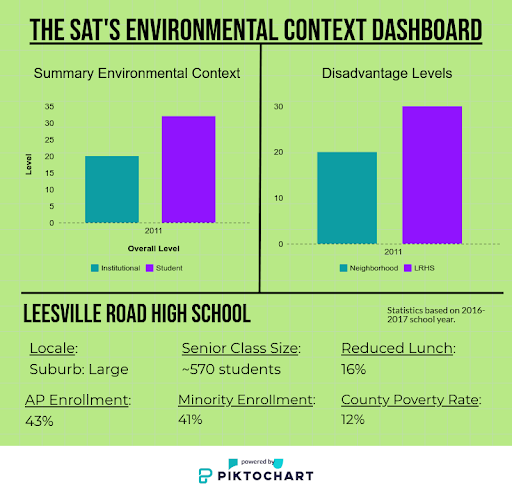
College Board is a non-profit organization that administers the SAT to over two million high school students a year. The organization has created a new “adversity score”, formally called the Environmental Context Dashboard, to even the playing field and potentially make college acceptance even more competitive. Because of the recent college scandals, wealth and privilege are now a hot topic of discussion when it comes to college attendance.
The new adversity score will measure multiple factors including family income, education opportunities, and crime rates in a student’s hometown. College Board is making an attempt to give all students truly holistic, or equal, acceptance to college and other further opportunities after high school. Instead of considering race, the organization will give the colleges access to an “adversity score” to determine the environmental factors in a student’s life and how they have an impact on a student’s test scores.
By implementing the new scoring technique, College Board will be able to gain a better comparison of scores between students. This means that an SAT score of 1400 will hold a different meaning to some colleges for two students from different backgrounds.
Take Student A, a person who comes from a household with a family income above the median in their neighborhood and a person who lives in a low crime area. Student B is a person who lives in a high crime area with an income close to the poverty line. For Student A, they may have had access to resources like test preparation classes. Additionally, the student would considerably be safer and exposed to better educational opportunities. Colleges might consider Student B to have endured more hardships throughout high school. Ultimately, this means that Student B’s adversity score is more significant in proving dedication to making a high test score.
As many, if not all, high school students hear time and time again, numbers do not make who you are. However, numbers do play a role in college acceptance. Colleges put test scores, grade point average, and class rankings into consideration when a university application is under review. Now that colleges will see the ECD, some students may face even more competitive standards. Although students will not see the score, some colleges will receive and review it as part of a standard application.
For some students at Leesville in particular, College Board’s new decision may bring major change when it comes to advancing towards a university. Many parts of Leesville are an upper middle class community with a very low crime rate. Housing values are rather high in many areas of the Leesville district and poverty rates are low. Within the school, there are many AP classes and rigorous class opportunities.
Disadvantage ratings will end up rather low for some students, meaning that test scores from other schools might make those students appear to be more hardworking. Students will have to learn to diversify themselves and build an application that truly stands out from the rest. Fortunately, this may not be the worst thing to happen to Leesville. Students may be encouraged to give back to the community in order to prove themselves to colleges. This could include varied volunteering opportunities as well as new service clubs to benefit the surrounding community of the school.
As well as bringing positive change to Leesville, students that continue to face disadvantages, especially at home, may prosper from the introduction of the adversity score. Applicants with lower test scores will now be able to provide an explanation for what is considered to be underperformance, but is truly disadvantage. A weaker transcript may not signify denial from universities anymore. Students from any background may now have access to the college of their dreams, a place where they can achieve goals and set new standards for the future.
College Board’s new investment can mean many things for a student. On one hand, people may have to work harder to prove that they are truly worthy of attending a college and have worked hard to get there. On the other hand, students from a background of disadvantage may be better recognized for the hard work they have put in throughout their high school career. Being nationally implemented in fall of 2020, colleges will begin to evaluate equality and dedication on a much more equal scale.